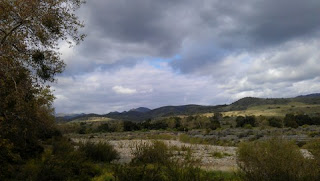Wildflowers
Caspers Wilderness Park, located on Ortega Hwy (a freeway alternate to the Inland Empire that winds through the Santa Ana mountains and spits you out in Lake Elsinore) is one of the places that really starts getting you into the local mountains of Orange County. I recently took the kids to their Wildflower event and even on a cloudy day, this place is beautiful. Right next door to Caspers is the Tree of Life Nursery that specializes in California Native Plants and often hosts talks on Native Plant gardening; it's a smallish, but great place to learn.
They had a booth with displays of our local flora

Apparently, we didn't have much rain early on this season so we're not seeing much of a show of Wildflowers this Spring - at least that's what the rangers tell me, but in some places, there are flowers galore. Like the hill I drive by every day; on one side it's a perfect yellow blanketed in mustard blooms, then on the other side it is a peachy orange covered with sticky monkey flower.
My friend Isabella pointed out that if you touch the very center of the stigma on a monkey flower, it closes up as if to say "I'm pollenated, thank you. Go find another!" Isn't that fascinating? Here's a not so great video of it. You really have to try it yourself to see.
My friend Isabella pointed out that if you touch the very center of the stigma on a monkey flower, it closes up as if to say "I'm pollenated, thank you. Go find another!" Isn't that fascinating? Here's a not so great video of it. You really have to try it yourself to see.
Here's a new beauty for me this year - Farewell to Spring. Don't you just love that name? They are reminiscent of Poppies, yet unmistakable with their blood red patches. They're blooming (of all places) in the parking lot at San Joaquin.
Thanks to an Audubon Pocket Guide I picked up randomly at a used library book store, I've started learning more about flowers. Last week, Isabella and I sat and took a closer look at composite flowers like these:
 |
| Encelia "California Sunflower" |
 |
| Dandelion |
 |
| A less mature Dandelion? |
This part in the back is called the "involucre" which consists of bracts.
Here are petals from each - well, in composite flowers each 'petal' is actually a flower in itself because it has all the parts necessary to produce a seed. These are the ray flowers - the outer flowers.
Here is a cross section of the California Sunflower. You can see the outer ray flowers, and the inner 'disk' flowers are very different.
Here are each of the disk flowers. The top left ones from the California Sunflower are clearly showing the yellow curled stigma and I believe the purplish part right below are the anthers. On the very bottom set from the dandelion, you can see the white feathery "pappus" which creates the globe of feathers the kids love to blow away. It's their wings that end up carrying the seeds far away to start again.
Here's a closer look at the dandelion's outer vs. inner flowers. You can see the one on the left is more mature. In both, you can see the ovary at the bottom where the seed will come from.
I've come away from this wondering if each of these individual flowers within the composite flowers need a bee to pollinate them or if they are somehow equipped to reproduce on their own. It seems every dandelion produces hundreds of seeds, but I can't imagine a bee has gotten to each one.
In any case, the amazing thing is that this is the first time in all my life I have really looked this closely at a flower. And isn't that just how nature study is? It's been there... all along.







Awesome post, Kristin. I wish I could homeschool next door to you. From what you publish, it seems like we have tons in common. Glad you are well.
ReplyDelete@citrusholly
I wanna go on a nature walk with you too!!
ReplyDeleteamy in peru